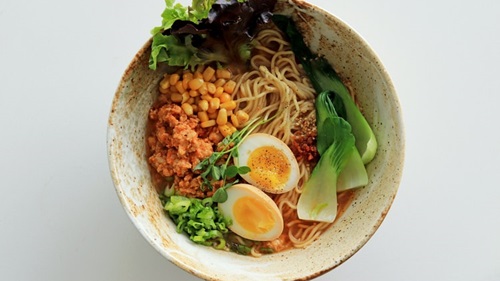
After nearly six years of living in this country, the food that is synonymous with Japan for me is ramen. The first neighborhood I lived in was in Nara, and it was only a short time after my arrival that my flatmates introduced me to the local ramen shop. To this day, it is the best ramen I have tasted anywhere in Japan. The broth at this particular shop isn’t salt, pork bone, soy or miso, but a unique blend of some or perhaps all of these. It also offered an exceptionally generous amount of high-quality sliced pork. Finally, the price was remarkably inexpensive – 800 yen for a bowl of ramen, or 1000 yen for a set consisting of ramen, gyoza, fried chicken, salad and rice.
I have sampled ramen across the length and breadth of the twenty-seven prefectures I have visited in Japan. There is no better meal to eat late at night, when most other restaurants have closed their doors. Ramen is hearty and comforting to eat in winter, but not impossible to consume on a humid summer’s day. Of course, eating tsukumen, ramen’s dipping broth cousin, is a logical alternative during the warmer months.
One aspect of eating ramen that I have yet to master is slurping. In a typical ramen shop, one will hear a cacophony from customers slurping to their heart’s content. I understand the principles behind the art of slurping, but lack both the physical and mental attributes to pull it off. One reason for this inhibition may be that eating soup-based dishes in a noisy manner is seen as poor manners in Western countries.
Some highlights in my ramen adventures across Japan include eating several bowls of Hakata ramen in Fukuoka. Indeed, in my hometown of Melbourne, a successful ramen franchise serving Hakata ramen has been operating for the past five years or so. The chef hails from Fukuoka, so the quality is authentic. The only drawbacks are the rather modest portion sizes and the exorbitant cost (over \2000 once toppings have been added).
Another highlight is eating butter corn miso ramen in Hokkaido. The dish perhaps takes richness to extremes, but exemplifies the variety of ways in which ramen is served. Special mention must also be made of “Ramen Street” in Kyoto Station. On my frequent sightseeing expeditions in Kyoto, the day or evening would typically begin with a bowl of ramen at one of the quality establishments on Ramen Street, which provided me with the necessary fortification to venture out to the temple/shrine/castle on that day’s schedule.
But let’s end with the Kanto region. My favorite ramen shop in this region would have to be Afuri ramen, which has branches across Tokyo and Yokohama. While tonkotsu (pork bone) ramen is always an appetizing choice, Afuri’s signature yuzu salt (shio) ramen is a refreshingly light alternative.
In summary, ramen is the clear king of soup noodle dishes in Japan, and it is often a challenge to limit my consumption to less than two bowls a week.
Ming
Vocabulary
synonymous (adj) – an extremely close connection between two things
cacophony (noun) – an unpleasant mixture of loud sounds
inhibition (noun) – a feeling of being embarrassed that makes it difficult to do something
exorbitant (adj) – much more than is reasonable
ネイティブ講師と話すならこちら!
英語学習をフルサポート!
マンツーマン&コーチングの英会話教室




















